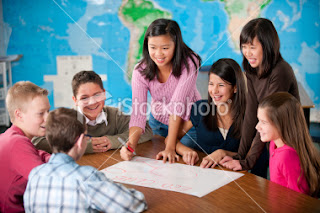One of the most important considerations is your target audience. Your game must reflect their knowledge, skills, and abilities. Games can evoke powerful learning. It begins when the student, now a player, is challenged with the information that provokes a search for the answer. When the correct answer is aired, the learning is immediately reinforced. This learning transfer happens over and over during the game. This moment of learning is not only powerful but often remains long after the learning event or game has been completed. Three dimensions of your target audience are level of play, number of players, and class size.
Level of Play
As you would expect, game play varies with the age of the audience in terms of the challenge of the material, the complexity of the rules, and the time of play. To assist you in sorting the games for your needs and audience, we have divided the potential audience into three groups with some distinct needs: grades K–2, grades 3–6, and grades 7–8.
- Grades K–2. Learning games for this group should focus on behavioral as well as intellectual skills. Children at this age may still be in the egocentric stage and are just beginning to be introduced to group play. This may make group work a challenge for the young student. Children will learn what games and group play mean overall—that games have winners, contain an element of challenge, and encourage competition. Using teams of fewer than five and simple concepts at the outset of game play allow children to focus on the rules of play. As the concept of a learning game is understood, you can build in additional task complexity.
- Grades 3–6. The focus for this audience continues to be how to work cooperatively in groups, but you can also put more emphasis on course curriculum. With students of this age it is developmentally appropriate to move them into larger teams. At this age students will also become very familiar with the concept of testing. Teachers can use games to teach their students about the content and the format of a test—easing their students into formal testing in a friendly environment.
- Grades 7–8. Learning games for this group can be expanded to familiarize students with written testing procedures, oral and written directions, forming and working in teams, individual and group problem-solving skills, and individual critical thinking skills.
When games are used in the classroom, any number can play. Although many games seem best suited for a small number of players, the intrigue and challenge of play invites the involvement of larger groups of participants. Interaction with the play of the game is vital because it brings your students into active contact with the topic.
Participation in a team is an important element of the game experience it immerses students in a collaborative learning environment. Teams not only present a collective approach to problem solving but also reduce the threat students might feel during a question-and-response period. If an individual responds incorrectly,
she may feel embarrassed or unprepared. If the team responds incorrectly, team members have a mixed experience of both disappointment and discovery. Working in teams also shows players that all learning does not have to come from the teacher.
The size of a good working team varies from two to seven players. Teams usually function better with an odd number of players, such as three, five, or seven. Try to use three-member teams unless the game rules indicate otherwise. Using three players allows all players to get involved in the responses and other aspects of game play.
Size of Class
The size of your class requires you to vary the focus of your control. In smaller groups you will be able to reinforce the topic during presentation of the question-and-response material. The natural energies and distractions of larger classes require more maintenance and direct control.
- Group size of 1 to 2. This very small group requires one-on-one skills from the educator and a game format that can be adapted to one-on-one play. The contest pits the player or players against a preset time or score. Feedback can be tailored to the student either in the form of an immediate score or as a mix of score and tutoring.
- Group size of 3 to 14. This small group allows a casual game atmosphere in which the teacher and students participate at a high level. In a small group there is time to go over each question, reach in-depth closure, and ensure each child understands the material. For a group of three to five players, consider having the students run the group, using the game as a learning center activity.
- Group size of 15 to 25. A medium group requires greater class management skills. The teacher must decide whether she will run one game for the entire class or break the class into teams for whole-group games—perhaps two to four games for this medium class size. Conducting multiple games requires you to make preparations for the additional activity, disruption, and noise.
- Group size of 26 to 46. A large group presents class management problems that require the teacher to decide whether he needs personnel assistance (other classroom monitors) and to plan room logistics that accommodate all the players. One method might be to divide the students into two sets and run the games in two rounds—in the first round one set of students acts as players and the second set acts as observers, and in the second round the roles are reversed. Again, remember that conducting multiple games requires you to make preparations for the additional activity, disruption, and noise.
Read More : Selecting An Appropriate Game For Your Classroom
